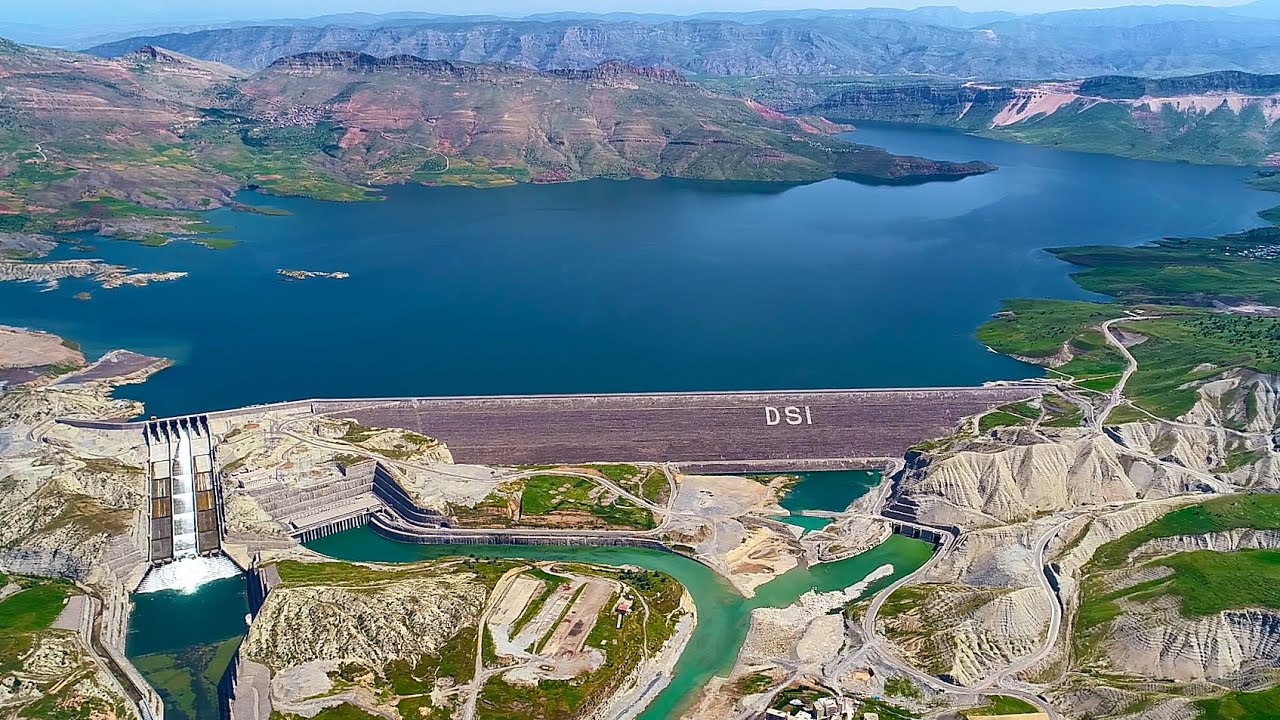The Cizre Dam is another dam to be built on the Tigris River. It will be the second-largest dam on the Tigris River after the Ilisu Dam. The main purpose of the dam is to irrigate a large area of agricultural land. Geographically, the construction site of the dam is located within the administrative boundaries of the district of Cizre, directly northwest of the district center, which is the city of Cizre. The Kurdistan Region and Iraq will also be affected. The main objective of this study is to highlight the negative internal and external impacts of the dam.

Map 1: Dams on the Tigris River and Its Tributaries in Turkey
Source: Researcher’s work, based on the use of software (ArcGIS 10.8)
Cizre Dam Construction Project
The Cizre Dam is another dam on the Tigris River in Şırnak province of North Kurdistan, northwest of Cizre city in the Kasrik area, Turkey, specifically at the confluence of the three mountains of Gabar, Kilise, and Judi. In terms of astronomical location, the dam is situated at a latitude of 37°21’40” North and a longitude of 42°9’39” East of the Greenwich Mean Time.

Map 2: Geographical and Astronomical Location of Cizre Dam
Source: Researcher’s work, based on the use of software (ArcGIS 10.8)
The construction of the Cizre Dam will have a negative impact on the area where the project is being implemented, as well as a serious impact on water security in the Kurdistan Region and the lower regions of Iraq. The aim of constructing this dam is to irrigate a large area of agricultural land in Cizre and Silopi, covering more than 120,000 hectares and producing 208 million kilowatt-hours of electricity.
Immediately after the parliamentary and presidential elections held on May 14, 2023, the first task of the Justice and Development Party (AKP) in Şırnak was to put the Cizre Dam project back out to tender, despite all the projected negative impacts on the environment. The construction of this dam will seriously affect water security in the Kurdistan Region and the lower regions of Iraq.
Due to the sensitivity of the subject, we have referred to an article on the ArtıGerçek website entitled “A history of six thousand years must be under the water of the dam,” which describes the construction of the Cizre Dam in Şırnak province. It is the tenth project on the Tigris River to have reached the final stage. Arslan Tatar stated in an article posted on social media that the tender for the project has been issued, work will start soon, and the project is planned to be completed within three years.
Although the tender for this project was issued on March 24, 2013, it was later canceled due to some problems. The dam will be the second-largest project on the Tigris River after the Ilisu Dam. The project is a joint effort by the Ministry of Forestry and Water Affairs and the General Directorate of Water Affairs of the State.
The dam will flood the Mahmoud Khan Bridge, which dates back to the Gothic period. The Krallar Geçidi strait, which has an important archaeological plaque and is visited by thousands of people every year, will also be submerged. With the completion of the project, the environment of the area and a large number of wildlife species will be threatened with extinction.
Negative Effects of the Cizre Dam
With the completion of the project, many residential areas, agricultural lands, and historical and archaeological sites will be flooded, and many animals will be destroyed. Additionally, areas that rely on the Tigris River, such as the Kurdistan Region and other parts of Iraq, will face a major water crisis. The dam will cause the Mahmoud Khan Bridge, which dates back to the Gothic period, to be flooded. This bridge was damaged by floods and later rebuilt.

Photo 1: Mahmoud Khan Bridge
The passage or strait of Krallar Geçidi, which separates the two mountains of Gabar and Judi, has a carving at its base depicting a knight on a horse. Thousands of people visit it every year. Some believe that the monument dates back to the Gothic period, while others, including Gertrude Bell, who first photographed the monument in 1909, believe that the carving depicts a bride and groom.

Figure 2: Carved Painting at the Foot of Krallar Geçidi
Abdullah Kultur, a resident of the area, said that the construction of the Cizre Dam has been on the agenda for many years. If the dam is built, residents will be forced to migrate and leave their homes. He added that they oppose the dam because it will destroy agricultural land, history, and the environment of their region. Despite the area’s historical significance, they urge environmental organizations and democratic institutions to oppose the project. If it proceeds, three villages will be flooded, and their inhabitants will be forced to migrate to big cities.
Another resident, Mohammed Kultur, emphasized that with the completion of the dam, the historical identity of the area will be submerged. The residents, who engage in agriculture and livestock breeding, will lose their land and livelihoods. Mohammed Kultur mentioned that several lawyers visited the area two months ago to observe the situation closely. “We, as residents, oppose the project because it will damage the environment and destroy historical monuments such as Mahmoud Khan Bridge, Kela Marjanarash, and the bride and groom monument,” he stated. Therefore, he calls on individuals to oppose the project.
Map 3: Construction Site of Cizre Dam
In short, the construction of the Cizre Dam is one of the most significant projects within the framework of the Southeast Anatolia Project (GAP) and was approved on August 16, 2023. Although the start date is unclear, Arslan Tatar mentioned that the dam will be 40 meters high and have a storage capacity of 381 million cubic meters, making it the second-largest dam on the Tigris River after the Ilisu Dam in Batman.
Along with climate change, the continued construction of Turkish dams will cause severe environmental problems in Iraq. A large part of the population in central and southern Iraq may be forced to migrate to different parts of the Kurdistan Region. The project will threaten the environment and many wildlife species and will flood roads, housing units, and gardens.
The amount of water flowing into Iraq through the Tigris and Euphrates rivers has decreased by 70% compared to the previous decade. According to a UN report, about 140,000 people have fled their homes in 12 regions of Iraq due to environmental issues such as a lack of water for agriculture.
Conclusion
Along with climate change, recurrent drought, and reduced rainfall, the Turkish government continues to build dams to control and absorb water from the Tigris and Euphrates rivers. In the near future, Iraq will face severe environmental challenges. A significant portion of the central and southern Iraqi population may be forced to migrate north, creating complex demographic problems in the Kurdistan Region.
-
This article, originally written in Kurdish by (Hawbash Abdullah Ahmad) and published in the Journal of Future Studies, was translated by (Lazya Ali) for Kfuture.Media.


